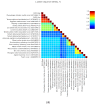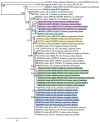Genomes of Alphanucleorhabdovirus Physostegiae Isolates from Two Different Cultivar Groups of Solanum melongena
- PMID: 39459872
- PMCID: PMC11512384
- DOI: 10.3390/v16101538
Genomes of Alphanucleorhabdovirus Physostegiae Isolates from Two Different Cultivar Groups of Solanum melongena
Abstract
Plant rhabdoviruses cause considerable economic losses and are a threat to the agriculture of Solanaceae plants. Two novel virus isolates belonging to the family Rhabdoviridae are identified by high-throughput sequencing (HTS) in Russian eggplant cultivars grown in the Volga river delta region for the first time. The phylogenetic inference of L protein (polymerase) shows that these virus isolates belong to Alphanucleorhabdovirus physostegia (Physostegia chlorotic mottle virus-PhCMoV), and their minus-sense RNA genomes have the typical gene order 3'-nucleocapsid (N)-X protein (X)-phosphoprotein (P)-Y protein (Y)-matrix protein (M)-glycoprotein (G)-polymerase (L)-5' observed in some plant-infecting alphanucleorhabdoviruses. One of the PhCMoV isolates from the eggplant cultivar Almaz is genetically very similar to the Russian PhCMoV isolate from tomato and grouped in a subclade together with four isolates from Belgium, Germany, the Netherlands, and France. However, another eggplant-infecting isolate from the Russian cultivar Boggart is the most divergent compared with the other 45 virus genomes of European PhCMoV isolates. Thus, our comparative analysis reveals that two virus isolates from Russia may either share a close evolutionary relationship with European isolates or significantly diverge from all known virus isolates. The potential to use the protein sequence comparative analysis of accessory polypeptides, along with the early developed strategy of the nucleotide sequence comparison of the RNA genomes, is shown.
Keywords: PhCMoV European isolates; Physostegia chlorotic mottle virus (PhCMoV); Russian PhCMoV isolates; high-throughput sequencing; nucleorhabdoviruses.
Conflict of interest statement
The authors declare no conflict of interests, including commercial interests. The funders had no role in the design of this study; the collection, analyses, or interpretation of data; the writing of the manuscript; or the decision to publish the results.
Figures






Similar articles
-
Discovery and Genome Characterization of Three New Rhabdoviruses Infecting Passiflora spp. in Brazil.Viruses. 2025 May 19;17(5):725. doi: 10.3390/v17050725. Viruses. 2025. PMID: 40431736 Free PMC article.
-
Detection and In Vivo Validation of Dichorhavirus e-Probes in Meta-Transcriptomic Data via Microbe Finder (MiFi®) Discovers a Novel Host and a Possible New Strain of Orchid Fleck Virus.Viruses. 2025 Mar 19;17(3):441. doi: 10.3390/v17030441. Viruses. 2025. PMID: 40143368 Free PMC article.
-
Merida virus, a putative novel rhabdovirus discovered in Culex and Ochlerotatus spp. mosquitoes in the Yucatan Peninsula of Mexico.J Gen Virol. 2016 Apr;97(4):977-987. doi: 10.1099/jgv.0.000424. Epub 2016 Feb 11. J Gen Virol. 2016. PMID: 26868915 Free PMC article.
-
Systemic pharmacological treatments for chronic plaque psoriasis: a network meta-analysis.Cochrane Database Syst Rev. 2021 Apr 19;4(4):CD011535. doi: 10.1002/14651858.CD011535.pub4. Cochrane Database Syst Rev. 2021. Update in: Cochrane Database Syst Rev. 2022 May 23;5:CD011535. doi: 10.1002/14651858.CD011535.pub5. PMID: 33871055 Free PMC article. Updated.
-
Diagnostic test accuracy and cost-effectiveness of tests for codeletion of chromosomal arms 1p and 19q in people with glioma.Cochrane Database Syst Rev. 2022 Mar 2;3(3):CD013387. doi: 10.1002/14651858.CD013387.pub2. Cochrane Database Syst Rev. 2022. PMID: 35233774 Free PMC article.
Cited by
-
The Emerging Role of Omics-Based Approaches in Plant Virology.Viruses. 2025 Jul 15;17(7):986. doi: 10.3390/v17070986. Viruses. 2025. PMID: 40733603 Free PMC article. Review.
References
Publication types
MeSH terms
Substances
Associated data
- BioProject/PRJNA1144656
- Actions
- Actions
Grants and funding
LinkOut - more resources
Full Text Sources

